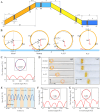An Ultra-Fast Rolling Double-Helical Robot Driven by Constant Humidity
- PMID: 40171820
- PMCID: PMC12199317
- DOI: 10.1002/advs.202500577
An Ultra-Fast Rolling Double-Helical Robot Driven by Constant Humidity
Abstract
Untethered soft robots made of stimuli-responsive materials hold great application potential in various fields. However, most robots of this type require artificial modulation of the stimuli to actuate, while it is a great challenge to achieve fast periodic locomotion under a constant external environment. Here, a double-helical robot constructed with humidity-sensitive agarose (AG) films, referred to as the Dualicalbot is proposed, which can rapidly roll under a constant humid environment by making two helices alternately bend by absorbing humidity to actuate the robot in two half-cycles. A theoretical model is built to unveil the periodic deformation of the robot as well as the correlation between the design parameters and the motion speed, based on which the Dualicalbot can reach a maximum rolling speed of 5.8 BL s-1. Moreover, it is capable of carrying a payload up to 100% of self-weight and detecting the acid environment it rolls through. This work is envisaged, and more generally the structural design and theoretical modeling principle, will open a new avenue for the development of advanced soft robotics with diverse functionalities.
Keywords: constant humidity; double‐helical structure; rolling locomotion; soft robot; stimuli‐responsive materials.
© 2025 The Author(s). Advanced Science published by Wiley‐VCH GmbH.
Conflict of interest statement
The authors declare no conflict of interest.
Figures




References
-
- Chen W., Tong D., Meng L., Tan B., Lan R., Zhang Q., Yang H., Wang C., Liu K., Adv. Mater. 2024, 27, 2400763. - PubMed
-
- Mu W., Li M., Chen E., Yang Y., Yin J., Tao X., Liu G., Yin R., Adv. Funct. Mater. 2023, 35, 2300516.
Grants and funding
LinkOut - more resources
Full Text Sources
